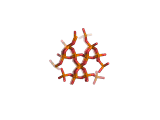Tue Mar 10 22:55:44 PDT 2009
The Smallest Useful Fragment of Silicon Dioxide?

The properties of sets of atoms effectively control the modern world. For example, the atoms you see above form a small piece of silicon dioxide or SiO2. This model contains around 180 atoms and at its longest dimension is approximately 1.5 nanometers, or 1.5x10-9m, long.
Although this is a very small number of atoms, and a very small distance from one end of the group to the other, this size range is important to today's electronic devices. 1.5 nanometers marks the practical minimum limit to the thickness of SiO2 that can be used as an insulator in a component on an electronic chip. If you make the layer of SiO2 any smaller than this, too much current will flow through the supposedly insulating layer, and the device will overheat. So, SiO2 based insulators have a practical limit to their minimum dimensions.
The minimum dimensions of components on a chip determine the number of components on the chip. The more component that can be squeezed onto a chip, the more powerful the CPU, and the more responsive and impressive your computer or telephone. Additionally, in the energy conscious world of today, the smaller the device is, the lower its power consumption. So there are considerable incentives for miniaturization. However, all good things reach a limit, and now with a silicon dioxide thickness of 1.5 nanometers, the tiny leakage current which runs through the otherwise insulating SiO2 layer is a limiting factor which threatens to impede the inexorable advance in computing power.
The solution, so far, has been to employ not faster CPUs but more CPUs. Hence we have multi-core machines. However, there are a range of technological improvements on the horizon which will very likely accelerate the pace of development. There are new materials which can be made to adopt smaller dimensions than SiO2 and yet possess acceptable properties in devices. Additionally, it is possible that non-solid state electronic devices, based on organic molecules and their electronic properties will one day be able to take over from the silicon based semiconductors of today. However, whatever the technology you can be certain that the dimensions of these devices will be made ever smaller and their properties will be determined by small numbers of atoms, as in the model above.